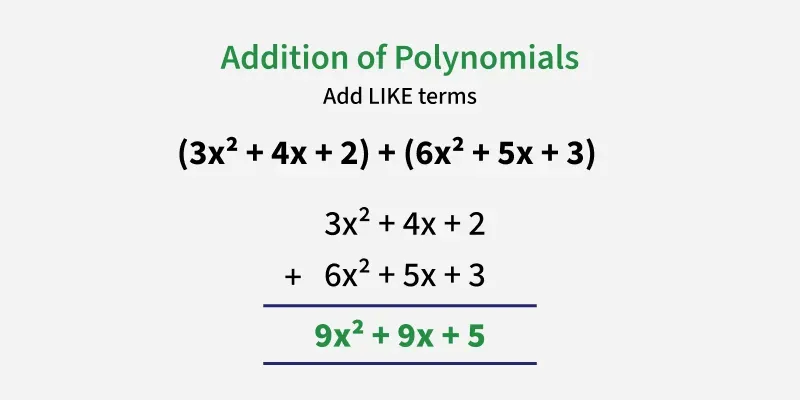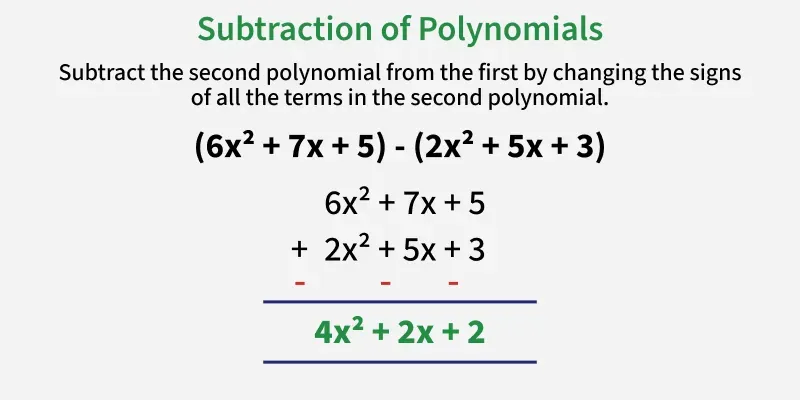Adding and Subtracting Polynomials
Polynomials are algebraic expressions composed of variables and coefficients, combined through addition, subtraction, and multiplication. Among the fundamental operations in polynomials, addition and subtraction require specific rules to ensure accuracy and consistency.




Standard Form of a Polynomial
a0xn+a1xn-1+a2xn-2+……..+anx0
Where
a0, a1, a2, a3,…. an are constants.
x is a variable
n is any whole number
- Examples of polynomials-
- x3 + 2x2 + x - 2,
- 2x2 - x + 1,
- 4x3 - 5x2 + 3x + 6.
Read More: Polynomials
Key Points to Remember
1. Like Terms: Always group and operate on terms that have the same variable and exponent.
- Example: 2x2 and 5x2 can be combined, but x2 and x cannot.
2. Standard Form: Arrange polynomials in descending order of exponents.
3. Addition Rules:
- Always take the like terms together while performing addition/subtraction. Like terms are the constants with variables having the same power/exponent. Example: 2x & 5x, 3x2 & 7x2.
- Signs of all terms in polynomials remain the same.
4. Subtraction Rules:
- Always take the like terms together while performing addition/subtraction. Like terms are the constants with variables having the same power/exponent. Example: 4x2 & 10x2, 6x3 & 7x3.
- Signs of all terms of a subtracting polynomial will get changed i.e., + changes to - and - changes to +.
Methods of Addition and Subtraction
We can perform addition/subtraction between polynomials in two ways. Either horizontally or vertically.
Adding Polynomials Horizontally
Before moving toward steps to perform addition, we need to remember the above-specified rules first.
Steps to Add
- Step 1: Arrange the polynomial in standard form i.e., arrange the polynomial in such a way that terms with variables having higher exponents are arranged first and lower at last.
- Step 2: Group the like terms i.e., variable having the same power/exponent.
- Step 3: Perform calculations.
Example: Perform addition between polynomials 3x2 + 2x + 1 and 4x2 + x + 9.
Solution:
Group like terms:
3x2 + 4x2 + 2x + x + 1 + 9Compute:
(3 + 4)x2 + (2 + 1)x + 10
7x2+3x+10
Adding Polynomials Vertically
Steps to Add
- Step 1: Write polynomials in standard form, and align like terms in columns.
- Step 2: Perform calculations.
Example: Perform addition between polynomials 3x3 - 2x2 + 1 and 4x3 + 7x2 - x + 9.
Solution:
Arrange polynomial one above the other in standard form and perform calculations.
3x3 - 2x2 + 0x + 1
4x3 + 7x2 - 1x + 9¯¯¯¯¯¯¯¯¯¯¯¯¯¯¯¯¯¯¯¯¯¯¯¯¯¯¯¯¯¯¯¯¯
(3 + 4)x3 + (-2 + 7)x2 + (0 - 1)x + 1 + 9
7x3 + 5x2 - x + 10
Subtracting Polynomials Horizontally
Before moving toward steps to perform subtraction, we need to remember the above-specified rules first.
Steps to Subtract
- Step 1: Arrange the polynomial in standard form i.e., arrange the polynomial in such a way that terms with variables having higher exponents are arranged first and lower at last.
- Step 2: Group the like terms i.e., variable having the same power/exponent.
- Step 3: Signs of subtracting polynomial get's changes i.e., from + to - and - to +.
- Step 4: Perform calculations.
Example: Perform subtraction between polynomials x+7x2+1 and 2x2-7.
Solution:
Step 1: Arrange polynomial in standard form.
7x2+x+1 and 2x2+0x-7
Step 2: Group like terms and Signs of subtracting polynomial get's changed and calculate the result
(7x2+x+1)-(2x2+0x-7)= (7-2)x2+(1-0)x+(1+7)
= 5x2+x+8
Subtracting Polynomials Vertically
Steps to Subtract
- Step 1: Arrange both the polynomials one above the other with like terms placed one above the other in standard form. And if any of the polynomials didn't have the variable with the same exponent as the above polynomial use 0 as a coefficient to avoid confusion.
- Step 2: Signs of subtracting polynomial get's changes i.e., from + to - and - to +.
- Step 3: Perform calculations.
Example 1: Perform Subtraction between polynomials 5x3 + 5y2 - 2z2 + 1 and 4x3 + y2 - x + 2.
Solution:
Arrange polynomial one above the other in standard form and perform subtraction.
5x3 + 5y2 - 2z2 + 0x + 1
4x3 + 1y2 + 0z2 - 1x + 2- - - + -
¯¯¯¯¯¯¯¯¯¯¯¯¯¯¯¯¯¯¯¯¯¯¯¯¯¯¯¯¯¯¯¯¯
(5 - 4)x3 + (5 - 1)y2 + (-2-0)z2 + (0 + 1)x + (1 - 2)
x3 + 4y2 - 2z2 + x - 1
Example 2: What is the resultant polynomial if we perform a subtraction between two polynomials 4a - 4b + c and 2a + 3b - c
Solution:
Arrange polynomials one above the other in standard form and perform subtraction
4a - 4b + 1c
2a + 3b - 1c- - +
¯¯¯¯¯¯¯¯¯¯¯¯¯¯¯¯¯¯¯
(4 - 2)a + (-4-3)b + (1 + 1)c
2a - 7b + 2c
Related Reads:
- Multiplying Polynomials
- Dividing Polynomials – Long Division
- Dividing Polynomials - Synthetic Division
